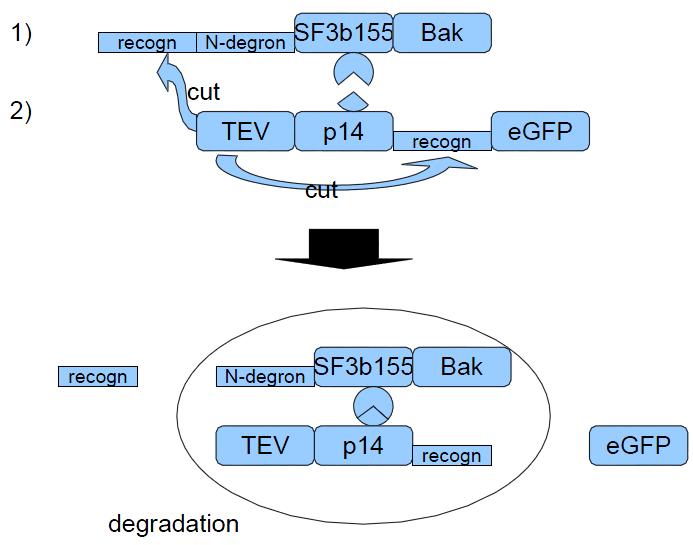TEVdegron-System
The TEVdegron-System uses and combines several proteins with different properties to select the incorporation of a plasmid by apoptosis. We need two DNA constructs and one of them (construct 1) should be integrated in the cell's DNA.
Construct 1
Construct 1 contains the following parts in this order:
CMV-promoter for the hygromycin resistance, hygromycin resistance, tetracyclin-inducible promoter, TEV-recognition site, N-degron, SF3b155, human bak.

To check the integration of this construct into cellular DNA we need the hygromycin resistance which can be read-off thanks to the CMV-promoter. The TEV-recognition site will be cut by the TEV-protease which is part of construct 2. Due to the scission of TEV-recognition site the N-terminus of N-degron is free which is a signal for the degeneration of this protein. SF3b155 is a protein interacting with p14 from construct 2. This interaction should make sure that the TEV-protease of construct 2 will really "find" the recognition site. The human bak is a apoptosis triggering membrane protein.
Construct 2
Construct 2 is composed of CMV-promoter, TEV-protease, p14, TEV-recognition site, eGFP and a double stop codon.

The CMV-promoter is to read off construct 2. The task of TEV-protease is to cut TEV-recognition sites, especially the one ahead of N-degron to signal protein degradation. p14 is interacting with SF3b155 and so increases the rate of finding the TEV-recognition site by the TEV-proteases. eGFP is our example of a gene of interest which can be verified by green flourescence.
Selection
A cellline which has integrated construct 1 and is transfected with construct 2 leads to two outgoings:
a) the plasmid has not been incorporated
b) the plasmid has been incorporated
These lead to the following consequences.
Case a) the plasmid has not been incorporated
After induction of the tet-on promoter construct 1 will be translated into protein. The bak-part will integrate into mitochondrial membrane and as a result will induce apoptosis.
Case b) the plasmid has been incorporated
Construct 2 will be read off and already existing when tet-on promoter will be induced to create construct 1 as protein. Therefore TEV proteases will instantly seperate eGFP from the remain of the protein and will free the N-terminus of N-degron. This will cause the degradation of the whole protein complex - including bak. So the cell will survive and only the gene of interest will be left.

|


![]()
![]()







![]()


![]()
![]()







![]()